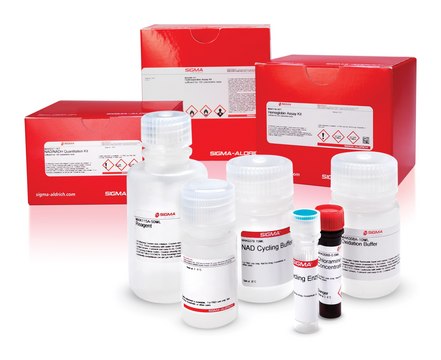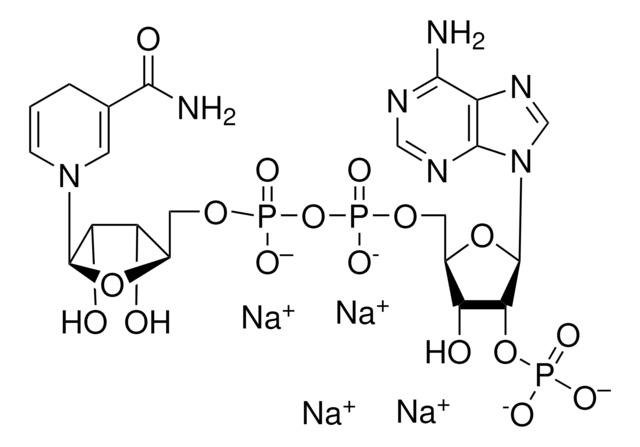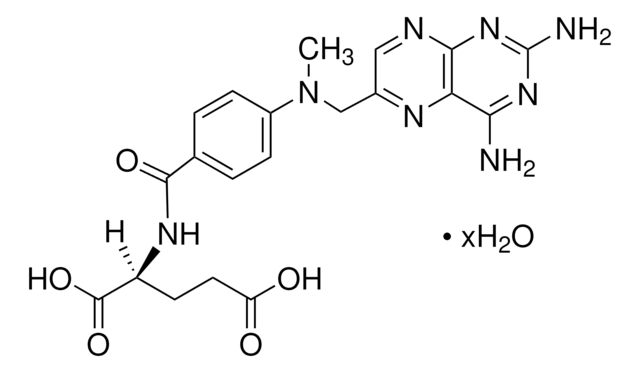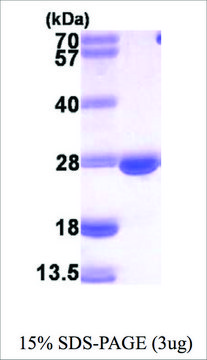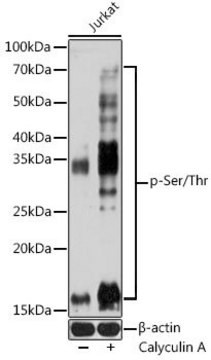D6566
Dihydrofolate Reductase human
≥80% (SDS-PAGE), recombinant, expressed in E. coli, ≥1 units/mg protein
Synonyme(s) :
DHFR, Tetrahydrofolate NADP+ oxidoreductase
Se connecterpour consulter vos tarifs contractuels et ceux de votre entreprise/organisme
About This Item
Numéro MDL:
Code UNSPSC :
12352204
Nomenclature NACRES :
NA.54
Produits recommandés
Produit recombinant
expressed in E. coli
Niveau de qualité
Essai
≥80% (SDS-PAGE)
Forme
solution
Activité spécifique
≥1 units/mg protein
Poids mol.
25 kDa
Concentration
0.02-0.06 mg/mL
Numéro d'accès UniProt
Conditions d'expédition
wet ice
Température de stockage
−20°C
Informations sur le gène
human ... DHFR(1719)
Description générale
Human DHFR is an 186 amino acid protein with an apparent molecular weight of 25 kDa. It is 30% homologous to the E. coli protein and up to 70% homologous to vertebrate proteins.
Application
Dihydrofolate Reductase human has been used:
- to investigate the stable expression of green fluorescent protein and the targeted disruption of thioredoxin peroxidase-1 gene in Babesia bovis
- to study the structural analysis of human dihydrofolate reductase as a binary complex
- to study its in vitro kinetic assay for the enzyme inhibition study
Human dihydrofolate reductase has been used in a study to investigate the stable expression of green fluorescent protein and the targeted disruption of thioredoxin peroxidase-1 gene in Babesia bovis. Human dihydrofolate reductase has also been used in a study to investigate the structural analysis of human dihydrofolate reductase as a binary complex.
Actions biochimiques/physiologiques
Dihydrofolate reductase (DHFR) is a key enzyme in thymidine synthesis. It catalyzes the reduction of dihydrofolate (DHF) to tetrahydrofolate (THF). At a much lower rate, it catayzes the conversion of folate to THF. Since thymidine is a necessary substrate for DNA synthesis, DHFR is a target for anticancer drug development. Methotrexate is the prototype dihydrofolate reductase inhibitor. The enzyme from Sigma has been used in the inhibitory studies of Leishmaniasis donovani pteridine reductase 1 (PTR1). The enzyme has also been used as a positive control to measure the DHFR activity of a protein, MS0308, purified from Mycobacterium smegmatis.
Km5,6
NADPH 0.16 mM
7,8-dihydrofolate 0.03 mM
8-methylpterin 0.13 mM
Ki7
Folate 2.6x10-5 mM
Methotrexate 6.1-9x10-9
NADPH 0.16 mM
7,8-dihydrofolate 0.03 mM
8-methylpterin 0.13 mM
Ki7
Folate 2.6x10-5 mM
Methotrexate 6.1-9x10-9
The human DHFR gene, as well as DHFR genes in other mammalian species, overcome the inhibitory effects of methotrexate by a mechanism of gene amplification or by amino-acid mutagenesis. Dihydroflate reductase (DHFR) catalyzes the NADPH dependent reduction of dihydrofolate (DHF) to tetrahydrofolate (THF) and, at a much lower rate, the conversion of folate to THF. The reaction product, THF, is an essential cofactor in the conversion of deoxyuridylate (dUMP) to deoxythymidylate (dTMP) by thymidylate synthetase. It is a key enzyme in thymidine synthesis. Therefore, DHFR is a critical enzyme in DNA synthesis and has become a target for drug development and cancer therapy. The variations between DHFR from different sources have enabled the development of species selective DHFR inhibitors, such as trimethoprim (antibacterial and antifungal), pyrimethamine (antiprotozoal), and methotrexate; MTX (antineoplastic, antipsoriatic, and anti-inflammatory).
Définition de l'unité
One unit will convert 1.0 μmole of dihydrofolic acid to tetrahydrofolic acid in 1 minute at pH 7.5 at 22 °C.
Forme physique
Solution in 10 mM Tris pH 8, 1 mM EDTA, 0.5 mM DTT, 5 μM NADPH, protease inhibitors, and 50% glycerol.
Substrat
Code de la classe de stockage
12 - Non Combustible Liquids
Classe de danger pour l'eau (WGK)
WGK 1
Point d'éclair (°F)
Not applicable
Point d'éclair (°C)
Not applicable
Équipement de protection individuelle
Eyeshields, Gloves, multi-purpose combination respirator cartridge (US)
Faites votre choix parmi les versions les plus récentes :
Déjà en possession de ce produit ?
Retrouvez la documentation relative aux produits que vous avez récemment achetés dans la Bibliothèque de documents.
Notre équipe de scientifiques dispose d'une expérience dans tous les secteurs de la recherche, notamment en sciences de la vie, science des matériaux, synthèse chimique, chromatographie, analyse et dans de nombreux autres domaines..
Contacter notre Service technique
